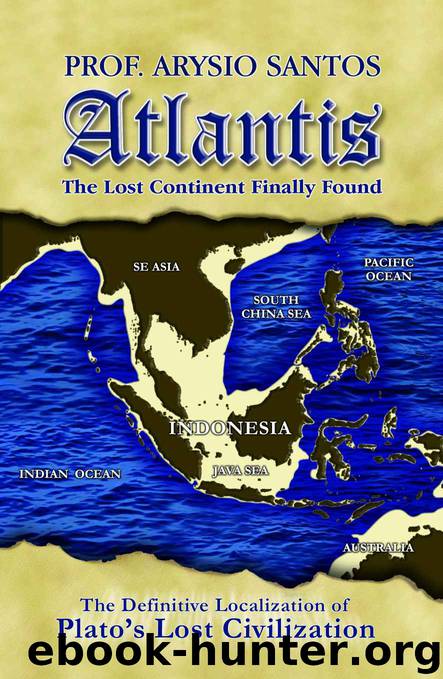Atlantis the Lost Continent Finally Found by Arysio Santos

Author:Arysio Santos [Santos, Arysio]
Language: eng
Format: epub
Publisher: Arysio Santos
Published: 2005-09-29T22:00:00+00:00
Robert Sarmast and the Cyprus’ “Discovery”
Let us now consider Cyprus, the object of the proposal recently made by Robert Sarmast, an Atlantologist who dedicated a considerable amount of time and, allegedly, money into this research of the seafloor in the region in his recent book: Discovery of Atlantis (Mt. Shasta, CA, 2003). Sarmast is a self-proclaimed researcher and has used a detailed study of the topography of the Mediterranean seafloor in the region of Cyprus done by oil prospecting companies working there.
Sarmast also claims that his Atlantis site accords with “51 out of 53 features given by Plato”. Alas, Sarmast’s research seems sorely flawed and doomed from the start. Besides, on reading his book it is essentially impossible to see how any of the claimed features of his site can ever be made to coincide with the ones given in detail by Plato: very extensive agricultural plains; abundant mineral resources; vast forests (Cyprus has always imported firewood and timber), and so on.
The fact that this site hinges, as the author himself admits, on the hypothesis that the Mediterranean Basin was dry as recently as 10 to 12 thousand years ago – the epoch of Atlantis’ cataclysm – turns it into a virtual geological impossibility.
According to this author, the Mediterranean Sea was closed off from the Atlantic Ocean by a dam across Gibraltar. This dam, he says, broke off at the date of the Atlantean cataclysm, and a monumental flood “swallowed up” the whole region of Atlantis in a terrible day and a night of pain, very much as Plato himself affirms.
But how is this possible if this flooding, even if real, was necessarily extremely slow and gradual rather than sudden and violent as Sarmast thinks?
The fact is that this flooding of the Mediterranean Sea actually lasted a full millennium or two. This rate of filling corresponds to something like 6 millimeters per day, something hard to perceive in practice. Some researchers in fact propose far larger rates of filling – reducing the time of flooding to something like 20 years or so. Even then, this rate corresponds to only about 1 centimeter /hour.
An annoyance, certainly, but far less than a disaster such as the Great Flood described by Plato, which occurred in the space “of a single day and a night of pain”. People would have ample time to evacuate the region, annoyed, it is true, but otherwise unharmed.
But there are other aspects of Sarmast’s theory that are even harder to believe. Many, many thousands of competent marine geologists – both scholarly and lay – have studied the Mediterranean seafloor with all types of sophisticated equipment such as side-scan sonar, multiple beam sonars, ROVs equipped with TV cameras, minisubs, oceanographic ships and so on.
It is hard to believe that they all failed to observe what Sarmast – an amateur at best – claims to have actually discovered. And their verdict is unanimous: the Mediterranean Sea has been full since about 5.2 million years ago, that is, since Miocenic times.
But what
Download
This site does not store any files on its server. We only index and link to content provided by other sites. Please contact the content providers to delete copyright contents if any and email us, we'll remove relevant links or contents immediately.
| Anthropology | Archaeology |
| Philosophy | Politics & Government |
| Social Sciences | Sociology |
| Women's Studies |
Mysteries by Colin Wilson(2885)
People of the Earth: An Introduction to World Prehistory by Dr. Brian Fagan & Nadia Durrani(2346)
Ancient Worlds by Michael Scott(2102)
Foreign Devils on the Silk Road: The Search for the Lost Treasures of Central Asia by Peter Hopkirk(2055)
The Memory Code by Lynne Kelly(1944)
Lost Technologies of Ancient Egypt by Christopher Dunn(1797)
The Splendid and the Vile by Erik Larson(1781)
Come, Tell Me How You Live by Mallowan Agatha Christie(1768)
The Earth Chronicles Handbook by Zecharia Sitchin(1744)
The Plantagenets by Dan Jones(1614)
Last Chance to See by Douglas Adams(1599)
The Return of the Gods by Erich von Daniken(1572)
Wars of the Anunnaki by Chris H. Hardy(1392)
Before the Dawn by Nicholas Wade(1315)
Keeper of Genesis by Graham Hancock(1279)
The Cygnus Mystery by Andrew Collins(1258)
The Message of the Sphinx by Graham Hancock(1222)
Fragile Lives by Stephen Westaby(1116)
Hieroglyphs: A Very Short Introduction by Penelope Wilson(1033)
